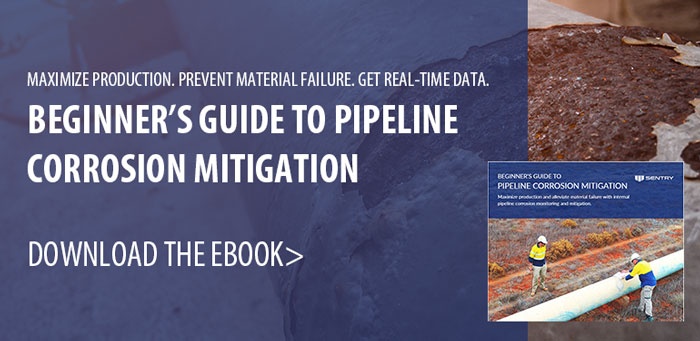
Read Part I in this series to learn about the tools used to monitor pipeline corrosion.
Pipelines carrying oil and gas experience internal corrosion when water is present inside the lines. The amount of corrosion will vary, depending on factors such as temperature, total pressure, CO2 and H2S content of the gas, pH of the water, flow conditions, use of inhibiting chemicals and more.
But no matter the amount of corrosion, it can have devastating effects on your equipment.
That’s why the Pipeline & Hazardous Materials Safety Administration, part of the U.S. Department of Transportation, mandates:
“Each operator must develop and implement a monitoring and mitigation program to identify potentially corrosive constituents in the fluid being transported and mitigate the corrosive effects.”
Pipeline Pigging isn't enough
To maintain pipeline integrity, many facilities use cleaning pigs within the pipelines to flush out water and prevent corrosion.
Oil and Gas Companies often decide not to conduct additional monitoring for internal corrosion based on the false belief that running pigs through the lines clears out the water from every portion of the pipe.
Monitoring within non-piggable lines is crucial, but even piggable systems aren’t exempt from the need for internal monitoring. Regardless of the type of line, choosing where to monitor is critical to your program’s success.
4 Steps to internal corrosion monitoring
1. Do a Quick Check with a Drip Pot
If you’re not sure if you have internal corrosion, you can perform a quick check by creating a low spot on your system with a drip pot assembly. This assembly provides a sample of all liquids in the system, as well as a corrosion coupon monitor and a bacteria collection device. This is also a great method for proving your chemical corrosion inhibitor program.
2. Choose Your Internal Monitoring Method(s)
As discussed in part one, lines can utilize non-intrusive monitoring methods, including:
- Flush-mounted weight loss coupons
- Flush-mounted electrical resistance (ER) probes
- Under-the-pipe drip pot assemblies
3. Identify Locations to Monitor for Corrosion
One way to identify monitoring locations is through process flow profiling.
Flow profiling is used to predict where water might travel and settle out of the process fluids. Water generally accumulates lower in the system and is swept upward with the process fluids. The sweeping is velocity dependent. Therefore, profiling where the velocity will change, such as pipe diameter changes and direction of flow changes, can determine where you should monitor.
Locations prone to corrosion and require monitoring include:
- Drips
- Separators
- Storage
- Low Spots in the Pipe
- Headers
- Dead Legs
- In Front of Damming System Components (Valves, Regulators, Orifice Plates, etc.)
4. Determine Monitoring Position
Monitoring occurs horizontally or vertically and requires varied methods of measurement and devices to execute.
Monitoring on a horizontal line requires the measurement element to be positioned close to but never touching the bottom of the line. Water is heavier than hydrocarbons, so it will settle along the bottom of the pipe. Because of this settling, you will want to position ER probes, UT probes and coupons near the bottom on a horizontal line and mount them from the 12:00 or 6:00 o’clock position regardless of the process type.
Monitoring on a vertical line, however, will require positioning the measuring element at the center of the flow. This is due to the positive process fluid movement being at the center of the pipe, away from the friction of the pipe walls.
By following these steps, you will help prevent corrosion before it even starts, keeping your equipment up and running longer.
Read Part III in this series to learn about executing mitigation techniques if you do encounter corrosion.
Sentry carries an extensive selection of corrosion monitoring products and services. Explore your options for upstream/midstream corrosion monitoring and chemical optimization solutions.




